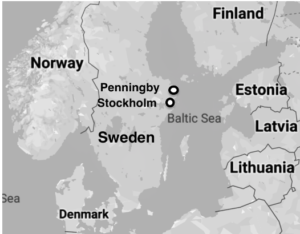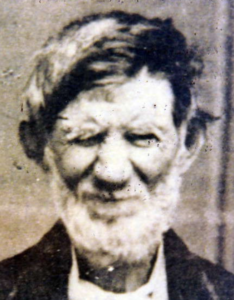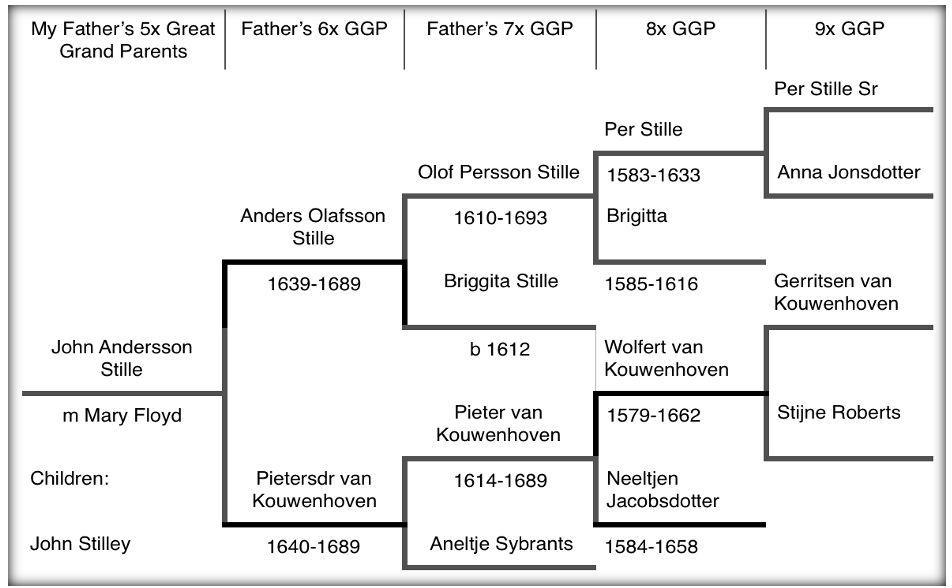We are about to meet the Stille family, whose surname has been Anglicized, Americanized and altered in countless record books. They are the ancestors of Jane Stilley, my father’s grandmother on his father Leb’s side of the family tree. This is the first full blown research of a matrilineal branch that I have revealed in this text.
The first of our Swedish ancestors arrived in the 1630s and became Stilleys, Steele, Steel and Steelman; to name a few. We descend from Olaf Stille, the first Supreme Court Justice of New Sweden. His journey began, as the son of Pers Stille, at Penningby Manor in Länna parish of Uppland, north of Stockholm. Olof was born on Solo Island, four miles east of Penningby.
The castle located on the grounds of Penningby Manor is well-preserved for a structure dating back to the Royal House of Vasa in 1523. Penningby Manor was held by Tord Bonde, a great Swedish magnate and warrior in 1380. He spent his life combatting the Russians on the Baltic Sea.
 Restored several times, over the centuries, Penningby castle is a national cultural heritage site. The castle is not inhabited, and visitors are welcome in the summer. The coordinates for Penningby: 59° 40′ 53″ N, 18° 40′ 21″ E. You can go to Google maps and zoom in on the manor and the isle of Solo to the east. Just type ‘Solo, Sweden’ in the search box. When Olaf migrated to New Sweden he settled into the Delaware River at present day Eddystone Pennsylvania. Legend has it that he and his family lived on an island in the stream.
Restored several times, over the centuries, Penningby castle is a national cultural heritage site. The castle is not inhabited, and visitors are welcome in the summer. The coordinates for Penningby: 59° 40′ 53″ N, 18° 40′ 21″ E. You can go to Google maps and zoom in on the manor and the isle of Solo to the east. Just type ‘Solo, Sweden’ in the search box. When Olaf migrated to New Sweden he settled into the Delaware River at present day Eddystone Pennsylvania. Legend has it that he and his family lived on an island in the stream.
In the 17th Century the Swedes often identified properties in rural areas as Hundred, a term implying an administrative unit within a larger county or province. Olaf’s New Sweden home was referred to as Christiana Hundred, likely a reference to the Queen of Sweden.
 The Stille migration proceeds in all directions from Olaf’s first home in ‘South Philly,’ which didn’t really exist in his lifetime. We find his descendants in New York, the Allegheny Mountains of Pennsylvania, Ohio, Maryland, North Carolina and Illinois. Jeremiah Stilley was the original Seahawk, the first settler in Seattle WA. Olaf’s descendants enslaved African Americans and were enslaved by Native Americans. It is quite a history.
The Stille migration proceeds in all directions from Olaf’s first home in ‘South Philly,’ which didn’t really exist in his lifetime. We find his descendants in New York, the Allegheny Mountains of Pennsylvania, Ohio, Maryland, North Carolina and Illinois. Jeremiah Stilley was the original Seahawk, the first settler in Seattle WA. Olaf’s descendants enslaved African Americans and were enslaved by Native Americans. It is quite a history.
I will begin this journey in the late 19th Century with my father’s grandmother, Jane Stilley, and go back in time to the iconic Olaf Stille. He will wait backstage, practicing his favorite sport: curling. He uses frozen cod instead of the present-day stones.
If this family tree were a stage production the director might be standing with megaphone in hand, shouting for all to hear, “Enter the Vikings, stage left.” While my father thought of himself as Irish, he possessed a greater dose of Celtic blood than he ever imagined. His lineage was infused with a high percentage of Welsh and Scottish DNA. What becomes quite clear when researching Jane Stilley’s history is that there was also an expansive and fantastic history of Swedish and Dutch heritage dating back to 1626 in New Amsterdam (Present day New York) and 1638 in New Sweden (present day Philadelphia, Delaware and New Jersey).
Pedigree Chart 7: The Stilley (Scandinavian)Lineage (Part 1 of 2)
Gen 4: Jane Stilley (1844-1927) and her Ancestors
My father’s Grandparents, of Williams Prairie, Williamson County IL
Jane Stilley lies buried in a cemetery in Lake Creek Township, NE ¼ NW ¼, Section 11, five miles northeast of Johnston City, IL within one of the eight expansive and fertile prairie areas of the county. Dating back to the mid-1800s, early settlers and natives traveled across this prairie on what was known as the ‘Old Trail.’ This crude, yet crucial trail began at Jordan’s Fort and traversed the land west to the Big Muddy River.
Among those early land prospectors using the ‘Old Trail’ was William Davis Stilley. Early land deeds in Illinois indicate that he was acquiring properties between the years 1840 to 1854. He eventually amassed more than 320 acres of prairie land. He became the namesake for William’s Prairie, William’s Prairie Baptist Church, William’s Prairie School and the Stilley Cemetery.
On April 20, 1881, “William D. Stilley and his wife Nancy Stilley for and in consideration of fifteen dollars deeded just over one acre of land for the purpose of a burial ground.” This was shortly after the burial of their son, Stephen Stilley, in November of 1880. Historical accounts and church records of what is originally known as the ‘United Baptist Church at William’s Prairie,’ instituted on June 15, 1861, suggests that the church’s first log meeting house may have been directly adjacent to this burial ground, 300 yards to the west of the present church and cemetery. The second and existing church was built in 1865.
There are several interesting families identified on Pedigree Chart 7. One of my favorites includes Grace Fountain, the wife of John Stilley. She was of French Huguenot descent and her ancestors were famed, prosperous and persecuted Huguenot aristocrats. They escaped assassination attempts in France and fled first to Ireland and then Maryland. Rachel Oldham is another important person. She descended from Thomas Oldham, one of the original pilgrim families at Plymouth Colony. Of course, these folks all important. If anyone were not available for breeding at the time, I suspect our DNA would be a bit different and none of us would be here in our present form! The one person who, of course, consumed my time and attention was and is Sarah Jane Fixes. It drives me crazy to find a person without parents in our tree. She seems to have started life in South Carolina, but I am at a loss to find any detail.
Jane Stilley and James Monroe Smith were the parents of several children, including my grandfather Lebanon. Leb was their youngest surviving child. Something happened in the marital relationship between Jane and James that inspired suspicion and created question marks for my father. Dad reported (in his Chronicles to Shelley) that Jane took up residency with Leb and Davis in North Dakota. The United States Census of 1900 indicates that Jane was living in Triumph, Ramsay County ND. At that same time James “took French Leave” (dad’s term) and went to live in Makanda Illinois with one of their daughters. A ‘French Leave’ is defined as an inexplicable departure from a commitment to an important relationship. In the military it would result in court martial. In a marriage it might lead to divorce. In fact, while I find no evidence, I do find other family historians located in southern Illinois, speculating that divorce did occur.
My father’s narrative indicates that Jane continued to live with Leb and Mary in the decade of the 1920s to the time of her death in 1927. James Monroe Smith died in 1910. Dad also points out that he (dad) had no memory of Jane whatsoever. He was only 4 at the time of her passing.
Gen 5: William Davis Stilley (1818-1890) and Nancy Swofford (1820-1888)
My Father’s Great Grandparents, New Bern NC to S. Illinois
 Jane Stilley’s parents had 13 children, each of whom made it to adulthood. That is uncanny and says a lot about the gene pool. As we shall see, old age was common among the Stilley ancestry; old age and stubborn judiciousness. The name William Davis runs rampant in this branch of our family tree. Jane’s father bestowed the name on one of Jane’s brothers, and that son gave the name in turn to his son. So, Leb and his brother Davis Smith had a cousin and an uncle, each named William Davis Stilley. The name also preceded Jane’s father. In fact, it is evidence of a pattern I pointed out in earlier chapters: Families honored cherished names in the family tree by playing the name forward in future generations. It kept the names of iconic family heroes alive. As we shall discover, William Davis and the Davis family, were indeed heroic figures on the New World stage in the 16th and 17th Century.
Jane Stilley’s parents had 13 children, each of whom made it to adulthood. That is uncanny and says a lot about the gene pool. As we shall see, old age was common among the Stilley ancestry; old age and stubborn judiciousness. The name William Davis runs rampant in this branch of our family tree. Jane’s father bestowed the name on one of Jane’s brothers, and that son gave the name in turn to his son. So, Leb and his brother Davis Smith had a cousin and an uncle, each named William Davis Stilley. The name also preceded Jane’s father. In fact, it is evidence of a pattern I pointed out in earlier chapters: Families honored cherished names in the family tree by playing the name forward in future generations. It kept the names of iconic family heroes alive. As we shall discover, William Davis and the Davis family, were indeed heroic figures on the New World stage in the 16th and 17th Century.
The Stilleys were equally important if we are talking world exploration and conquest. There is a vast difference in style when comparing the Davis men and Stilleys as they moved into the new world. I will come to that difference as time permits. Right now, I need something to eat! We will detail Nancy Swofford’s lineage, later. I found few families as given to their faith in God as the Swoffords over generations of time.
Editor’s Note: Dr Smith disappeared from his office at this point and took an inordinate amount of time to prepare his favorite dish, jambalaya. When this happens we simply wait for the effect of the peppers to wear off before we let him back into any room we might share.
Smith Continues: Okay. I’m back. William Davis Stilley (Jane’s father) was the son of Davis Stilley and Lydia Rogers.
Gen 6: Davis Stilley (1785-1847) and Lydia Rogers (1786-1823)
My Father’s 2nd Great Grandparents, New Bern NC to S. Illinois
Davis Stilley, born in New Bern, NC in 1785, died in Williamson County, Illinois. Lydia Rogers died during childbirth and was buried with her child on the Davis’ farm along Illinois Highway 149 between West Frankfort and Thompsonville in Franklin County, Illinois.
Davis Stilley was the son of Hezekiah Stilley and Sarah Davis. His Bible states his birth year as 1785; however, his original gravestone stated 1784. Davis left North Carolina with his uncle Stephen Stilley (aka- ‘the Elder’) and other Stilleys in 1802. They settled in Franklin/Williamson County, Illinois. He was originally buried on his farm near Crab Orchard Lake in Williamson County. However, a coal company moved his grave and he was re-interred in the Stilley Cemetery in 1969. His first wife, Lydia Stilley nee Rogers, was also re-interred to Stilley Cemetery in 1967. His second wife was Hannah Moore. Her burial location is not known.
The Bible records of William Davis Stilley are some of the most complete such records found among the archives. Kudos to William for being meticulous and to Peggy J. Stilley Morgan, who has shared the info with the rest of us. In 2015 Ms. Morgan took time to transcribe every note provided by William D. Stilley. She also described her efforts:
“The greater part of these records are written with a quill probably in the hand of Davis Stilley. A few names have been added in later years, by someone else, with a pen. The writing is very faded, the paper deteriorated, and the pages torn. Using a magnifying glass, I have tried to translate this with the greatest care possible, sometimes referring to other documents to verify accuracy. Even so, there are possible discrepancies. This has been copied exactly as written, except headings have been added by me to determine relationships. I hope this information may be of help to some of you.”
Gen 7: Hezekiah Stilley (1763-1840) and Sarah Davis (1764-1811)
My Father’s 3rd Great Grandparents, Hyde County NC to Makanda IL
This is the marriage that brought the Davis name into the Stilley tree, and vice-versa. Several dramatic family histories come together with this single marriage: the Stille Scandinavian/Dutch family, the Davis (Welsh) heritage and the de la Fontaines (French Huguenots) all converge the night Hezekiah and Sarah conceived their first child. I will dedicate a chapter to our Davis (Welsh) kin and touch on the French (de la Fontaines) momentarily. As we move further back into the Stille lineage we will find Dutch ancestors making world history on a grand scale.
Hezekiah was born in Somerset, Maryland, the son of John Stilley (1715-1795) and Grace Fountain. John moved south with his family to Hyde County NC, a county that had once been a part of a larger county known as Ablemarle. It was in Hyde County that Hezekiah married Sarah Davis and moved into the Davis neighborhood, ‘six doors down’ from her father, William Davis, Sr. We know they lived nearby because the 1790 census takers recorded and enumerated each family in relationship to their neighbors. In other words, the census taker went right down the road and recorded families in the order in which they lived on their country lane. We are talking plantations not neighborhood houses lined up one after the other on a village street.
I have spent a lot of time trying to reconstruct the Hyde County neighborhood in the decade from 1700 to 1800 and have had great success establishing a core community that migrated together, intermarried and engaged in commerce. The names which appear as Hezekiah’s neighbors include folks in our family tree: Winfield, Callaway, Davenport, Satterthwaite, Morris and Rogers, all associated with Hezekiah Stilley and his father-in-law, William Davis, in various transactions. I will reveal that information in greater detail when we focus on Sarah’s father, William Davis, and his ancestors.
Hezekiah and Sarah Stilley had 8 children, 6 boys and 2 girls. The first son, Davis Stilley, was born in 1785 and the last child, daughter Deney Anne was born in 1811. The year of birth is the same as Sarah’s date of death, suggesting that Sarah did not survive the child’s birth. We do know that Hezekiah and his family moved from North Carolina to southern Illinois in 1803. The date is significant. Illinois was not yet a state in 1803. The land was part of the Northwest Territory of the United States. The British were not yet resigned to the fact they had lost the territory during the Revolutionary War. Per the Treaty of Paris (1783), Britain officially did cede the area north of the Ohio River and west of the Appalachians to the United States. But the British still controlled Canada, and aspired to control the Great Lakes, Ohio and Mississippi Rivers. They maintained a presence in the region as late as 1815, which marked the end of the War of 1812.
The American Squatters Report of 1807 (true) revealed that pioneers had already established a presence in southern Illinois. These squatters were the first Americans to settle in Illinois and included Hezekiah and Sarah Stilley. In 1803, the Piankashaw and Illini tribes ceded their rights to over nine million acres in southern Illinois. Only those settlers occupying government land before March 3, 1807, were permitted to remain on their homesteads. If these settlers had occupied the land and made improvements, they could petition the federal government for permission to purchase a quarter-section of land at a private sale. Stephen Stilley along with his brother Hezekiahl and Hezekiah’s son, Davis made application and turned their ‘squatter’s rights’ into a legitimate ownership of their land.
The Land Office of the United States of America at Kaskaskia, Il has the application and record of the permissions granted.
On Dec. 30, 1807, ‘Hezechial Stilleg’ filed for permission to buy what was previously Indian land he had lived on and made improvements. The record refers to 320 acres located in R9, T12, 8 NE SE qrs.
Gen 8: John Stilley (1715-1795) and Grace Fountain
My Fathers’s 4th Great Grandparents, Somerset MD to Beaufort NC
John Stilley, Hezekiah’s father, married Grace Fountain, daughter of Stephen Fountain and granddaughter of a French Huguenot immigrant named Nicholas de la Fountaine.
This matrilineal branch of the family tree is expanded in as OUR HUGUENOT FAMILY
Gen 9: John Andersson Stille (1683-1774) and Mary Floyd (1688-1774)
My Father’s 5th great grandparents, Christiana Hundred, Delaware
The birth of John Andersson Stille in 1683 in Christiana Hundred represents the union of two powerful and iconic families in early American history, the Stilles of New Sweden and the von Kouwenhovens of New Amsterdam. The lineage of each family is laid out in Pedigree Chart 8.
The history of these families is very well documented in terms of the making of America.
Pedigree Chart 8: Swedish and Dutch Ancestors (Part 2 of 2)
The branch of the family tree began when Jane Stilley married James Monroe Smith (See Chart 7). To the left of this Chart 8 you see John Andersson Stille and his wife Mary Floyd. They resided in Virginia. Their son John and his wife, Grace Fountain, spent their later years in coastal Carolina. The immigrant Stilles, with Olaf and Briggita leading the way settled into New Sweden on the outskirts of present-day Philadelphia. In fact, their original homestead is now a loading dock at a large rail terminal on the Delaware River. I don’t think Olaf would recognize it as home.
Chart 8 includes several of my favorite characters found in our family history. They rival William Bailey Smith in terms of historical significance and in terms of living life on the edge. Just briefly now, as sort of a teaser to get you to read more about them:
–Olof Persson Stille escaped execution in Sweden and became a Supreme Court Justice in New Sweden, before there ever was a United States of America.
–Wolfert Gerretse von Kouwenhoven and his wife Neeltjen Jacobsdocter were the first Europeans to purchase land from the Natives of New England. They were important cogs in the creation of New Amsterdam. Prior to their purchase, immigrants were squatters on Native lands, seizing land without compensation.
–Pieter Wulfertsen von Kouwenhoven opened a pub and microbrew in which George Washington and the Sons of Liberty would eventually plot the birth of a nation.



